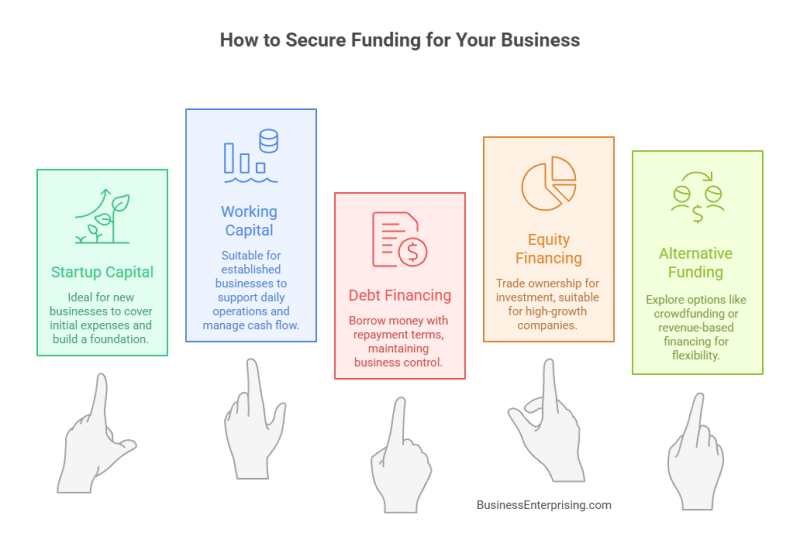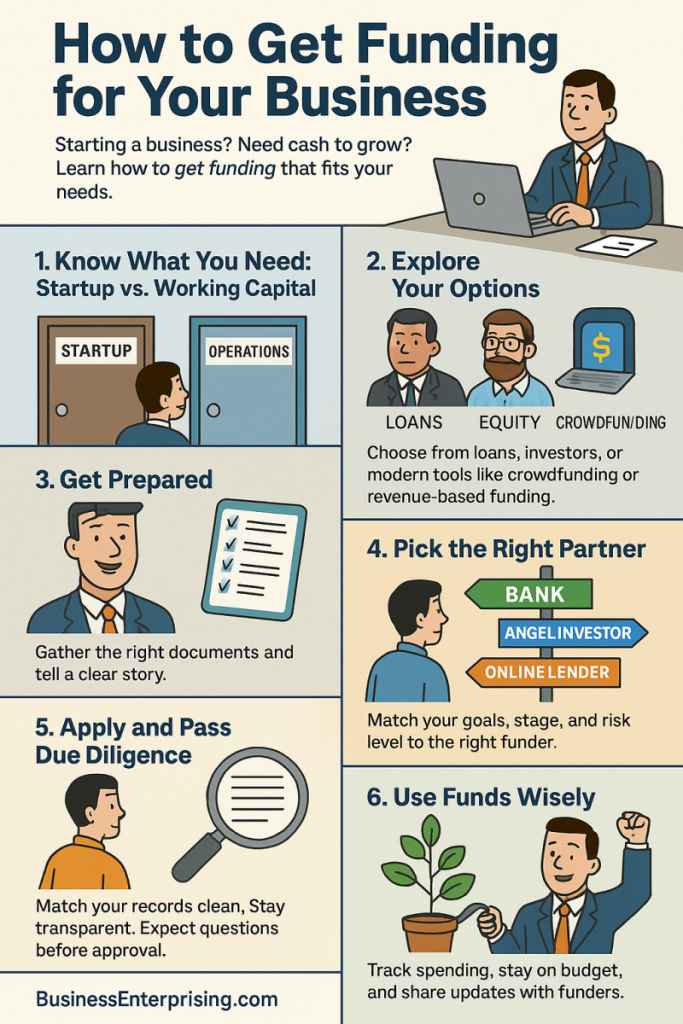
Additionally, your business stage shapes what type of capital fits best. A new business needs startup funding to cover early expenses. However, an established company may seek working capital to support daily operations. Therefore, knowing where you stand helps you choose the right path forward.
Different funders offer different terms and benefits. Banks may offer loans with fixed rates. Investors often trade money for equity. Therefore, you need to weigh your options and decide what matters most. Some founders value control. Others need flexibility or larger sums.
Before applying, make sure your materials are ready. A solid plan and clear financials help others trust your judgment. Additionally, good preparation shows that you take your business seriously. When your story makes sense, your odds improve.
Learning to raise money is part of building a strong business. If you stay organized and focused, your funding efforts can pay off. Every step matters, from choosing the source to managing the funds. Start with a clear goal, and move forward with purpose.
Understanding Your Funding Needs: Startup vs. Working Capital
Understanding what type of capital your business needs will help you make smarter funding decisions. Not all funding is the same. Startup capital helps you get off the ground. This may include money for equipment, product development, marketing, or hiring staff. You are building the foundation and need upfront cash to begin operations.
On the other hand, working capital supports your daily business functions. It covers short-term needs like payroll, rent, or supply costs. You may already have revenue but still need help balancing cash flow. Many businesses apply for working capital to handle seasonal dips or growth phases.
Therefore, it’s important to define your stage of business before seeking capital. If you are pre-revenue, your focus should be startup funding. Once you generate consistent sales, your funding needs usually shift. Additionally, industry type can affect how much capital you require. Tech startups often need more early investment than service-based companies.
Your growth goals also matter. If you plan to scale quickly, you’ll likely need larger investments. If you want stable operations, smaller funding may be enough. That’s why timing and purpose play a big role. Investors and lenders look at how you plan to use the funds. They want a clear and reasonable plan.
Before you approach anyone, you should know how much funding you need and why. That clarity helps build confidence. It also makes it easier to decide how to get funding that fits your needs. Think through your goals and match your request to the right stage of growth. Planning carefully now can prevent bigger problems later.
Exploring Funding Options: Debt, Equity, and Alternative Sources
When you explore funding options, it helps to understand the three main categories. Each one serves a different type of business. Debt financing is the most common. This includes bank loans and credit lines. You borrow money and repay it over time, usually with interest. You keep control of your business, but take on risk if sales fall short.
Equity financing works differently. You trade ownership for investment. Angel investors and venture capital firms give you money in exchange for a share. You don’t have to repay them, but you give up some control. Therefore, it’s better suited for high-growth companies that need large capital and fast scaling.
Additionally, you can consider alternative funding sources. Crowdfunding lets you raise money from many people at once, often online. You offer rewards or early access instead of ownership. Revenue-based financing is another modern option. Instead of fixed payments, you repay a percentage of your monthly revenue. This can offer more flexibility during slow months.
Your choice depends on your business model, goals, and risk tolerance. Some founders avoid debt. Others prefer loans over giving up equity. Therefore, you need to compare repayment terms, cost, and control. No method fits every business. The right choice depends on your specific situation.
Before deciding, think through your long-term plans and cash flow. If you want to know how to get funding that fits, first decide what you’re willing to give up. Whether it’s control, repayment flexibility, or time, each funding option comes with trade-offs. Pick the option that matches your priorities.
How to Prepare for Funding: Business Plans, Financials, and Pitch Materials
Before you ask for money, you need to prepare your materials. Investors and lenders expect to see a complete picture. A clear business plan shows what your business does and how it makes money. It should explain your market, pricing, team, and future goals. If your plan is too vague, you risk being ignored.
Financial projections help build confidence. They should include income, expenses, and profit forecasts for at least a few years. Additionally, your numbers should match your growth strategy. If they look unrealistic, funders may question your judgment. Therefore, take time to build projections that reflect current market conditions.
You also need a use-of-funds statement. It outlines how you will spend the money. This shows that you’ve thought through your budget and priorities. Funders want to know where their money will go. A clear breakdown of expenses helps them feel more secure in their decision.
Additionally, your pitch materials need to be strong. If you’re seeking equity, your investor deck should tell a tight story. It must explain why your business is worth backing. If you’re applying for a loan, your application should be complete and easy to follow. Therefore, keep your message focused and well-supported.
Learning how to get funding starts with showing funders you are ready. Preparation builds trust and shows that you take the process seriously. Take the time to get it right. The effort you make now can help you stand out from others who are less prepared.
Choosing the Right Type of Lender or Investor for Your Business
Finding the right funding partner means knowing what fits your business goals. Not every lender or investor is a good match. If you need money fast, online lenders may offer speed but charge more in interest. However, traditional banks might offer better rates if your credit and documents are strong.
If you prefer flexibility, private lenders may work better. They can offer terms that feel more personal. However, they may also take on more risk, which affects cost. Additionally, if you want guidance along with money, angel investors might be a good fit. Many bring experience and want to help you grow.
Venture capital firms often seek high-growth companies. They invest large sums but expect big returns. Therefore, they usually want equity and influence over decisions. You should only consider them if you plan to scale quickly and are open to outside input.
Additionally, your stage of growth matters. Startups often can’t meet bank requirements. In that case, you may need to consider private equity or grants. More established businesses might qualify for better loan terms or larger funding amounts. Therefore, your timing affects your options.
Before choosing a funder, think about what you want to give and what you expect to get. Consider control, speed, cost, and long-term plans. Learning how to get funding includes understanding which trade-offs you’re comfortable making. Pick the partner that matches your values and business strategy.
Navigating the Application and Due Diligence Process
Once you decide to apply for funding, be ready for a process that takes time and attention to detail. Every lender or investor wants to see that your business is prepared. That starts with gathering the right documents. You will likely need financial statements, tax returns, and legal records.
Additionally, creditworthiness plays a big role. Lenders review your business credit and often your personal credit too. If your score is low, you may need to explain why. Therefore, check your reports before applying and correct any errors. A strong credit profile can improve your chances and terms.
Funders also look for consistency. Make sure your documents match your story. If your pitch says one thing and your financials say another, that raises concerns. Additionally, unclear or missing information creates delays. It can even disqualify your application. Keep your records current, organized, and easy to review.
During due diligence, expect deeper questions. They may ask about past debt, legal issues, or revenue patterns. Be direct and honest in your answers. If there are red flags, address them with facts. Avoid hiding problems. Transparency helps build trust.
Learning how to get funding means knowing what funders expect before they write a check. Preparation shows you take the process seriously. Take the time to review your materials and clean up weak spots. A smooth process makes a better impression and may improve your outcome.
Post-Funding Best Practices: Managing Capital and Reporting to Stakeholders
After you receive funding, the real work begins. Now you must manage that capital with care and clear purpose. Every dollar should support a goal. Use the money to improve operations, boost sales, or build assets. Avoid spending on items that don’t drive results.
Additionally, set a clear budget before spending starts. Track your cash flow closely. If something changes, adjust quickly. Funders want to see that you make smart, data-based choices. Therefore, plan ahead and check progress often.
You also need to meet reporting expectations. Investors and lenders want updates. They expect to see financial reports and project results. Therefore, schedule regular check-ins and send clear reports. These should show how the funds are being used and what progress you’ve made.
Transparency matters. If your business hits a roadblock, say so early. Explain what happened and how you plan to fix it. This helps build confidence. Most funders don’t expect perfection. They expect communication and responsibility.
Additionally, track your key performance metrics. This gives you insight into what’s working and what needs to change. When you show results, you keep funders engaged and supportive.
Learning how to get funding also means learning how to keep it. Respect the capital you’ve raised and use it wisely. Your success after funding can open doors for future support.
Conclusion
Securing capital takes planning, effort, and clear thinking. You need to know what kind of funding fits your goals and timing. Before applying, take time to prepare your documents and sharpen your message. A strong plan shows funders that you’re ready.
Additionally, the way you manage capital after funding matters. Use funds carefully and stay focused on results. Keep your reports timely and your updates honest. Funders value businesses that stay organized and communicate clearly.
Therefore, think long-term when choosing a funding path. Don’t rush into offers that don’t align with your goals. Ask questions, compare terms, and weigh the trade-offs. The more informed you are, the better decisions you’ll make.
Your options will change as your business grows. What worked in year one may not work in year three. Keep learning, reviewing your numbers, and adjusting as needed. Building relationships with funders can help you access more support down the line.
Learning how to get funding is more than writing a pitch. It’s about building a business that deserves investment. When you plan carefully and act responsibly, you gain more than capital. You earn trust, open doors, and grow with confidence. Funding is a tool, not a finish line. What you do next shapes what comes after. Stay focused, stay clear, and use what you’ve raised to build something strong.



